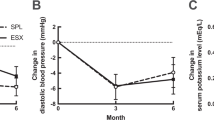Abstract
The possibility that medroxyprogesterone acetate (MPA) is clinically effective at least in part by its suppression of adrenal steroidogenesis and a resultant reduction of circulating oestrogen levels was investigated in 49 postmenopausal patients with advanced breast cancer. Thirty-one patients were treated with low dose MPA (100 mg three times daily) and 16 patients with high dose MPA (250 mg four times daily). Plasma levels of androstenedione, testosterone, oestrone and oestradiol were all significantly reduced during treatment, with the suppression being most marked for the 17 beta hydroxysteroids, testosterone and oestradiol. The fall in oestradiol levels was to about 50% of pretreatment levels, but a concomitant fall in SHBG levels to less than 25% of baseline probably resulted in the fall in free, biologically active oestradiol being only to about 70-80% of pretreatment. It is unlikely that this is a major determinant of the activity of MPA in breast cancer.
This is a preview of subscription content, access via your institution
Access options
Subscribe to this journal
Receive 24 print issues and online access
$259.00 per year
only $10.79 per issue
Buy this article
- Purchase on Springer Link
- Instant access to full article PDF
Prices may be subject to local taxes which are calculated during checkout
Similar content being viewed by others
Rights and permissions
About this article
Cite this article
Dowsett, M., Lal, A., Smith, I. et al. The effects of low and high dose medroxyprogesterone acetate on sex steroids and sex hormone binding globulin in postmenopausal breast cancer patients. Br J Cancer 55, 311–313 (1987). https://doi.org/10.1038/bjc.1987.61
Issue Date:
DOI: https://doi.org/10.1038/bjc.1987.61
This article is cited by
-
Megestrol acetate-induced adrenal insufficiency
Clinical and Translational Oncology (2008)


